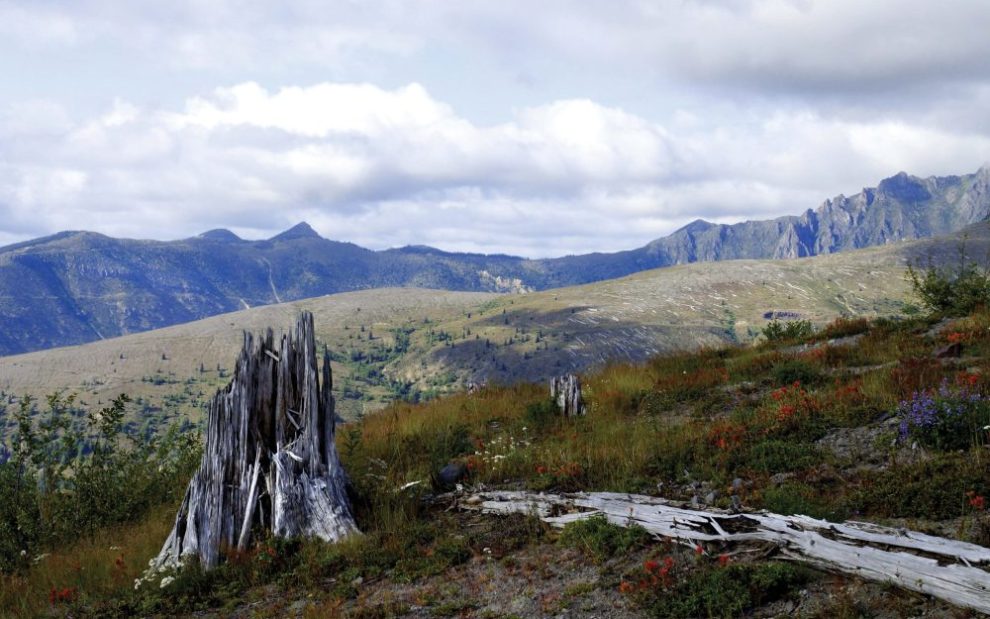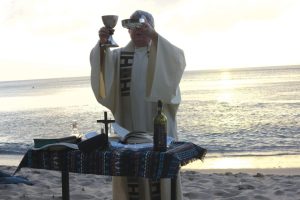I stood more than 4,000 feet above sea level—close to one mile. As I approached the Johnston Ridge Observatory in the Cascade Mountains, the world opened up and I beheld something awesome: the glacier-flecked, smoking remains of a volcano.
Although it has carried the European name Mount St. Helens since 1792, many Native peoples speak of it as Loowit. The Klickitat peoples call it Louwala-Clough, the Cowlitz peoples call it Lavelatla (“the smoker”), and the Puyallup peoples call it Loowitlatkla (“lady of fire”). These names predate the Europeans by millennia.
I had visited Loowit 16 years earlier when I lived in Seattle. At that time, I was put off. The destruction from its 1980 eruption—the year I was born—still dominated the surrounding landscape for miles on end: Mountains and valleys were clothed with dust, rocks, and tree stumps, and they were mostly devoid of life. A few rivers and streams ran through the area, and some lakes and glaciers dotted the landscape. But it was more similar to a moonscape than a life-giving ecosystem.
This time, the world around the volcano had changed. The once desolate landscape now grew verdant and teemed with life. Wildflowers in the meadows were plentiful. Tall pines, cedars, and broadleaf trees had returned. They created a canopy for ferns, bushes, berries, and all kinds of other plants to grow under their protection. These, in turn, created a home for more life. Hawks, eagles, and other birds soared above the trees while small animals and insects scurried about their business below.
In the 42 years since its eruption, and the 16 years since my last visit, the land has undergone a kind of resurrection. Much of the reason for this is simply because we humans got out of the way. Sometimes human cooperation with God asks for us to yield and let God’s Spirit move. Instead of trying to solve a problem that is beyond our power, we back off, observe, and wait.
We see a similar discipline practiced by the earliest disciples at the initiation of the Christian paschal mystery. The disciples who do not flee after Jesus’ passion and execution, especially Mary Magdalene and the other women who keep vigil, display a paschal discipline in the aftermath of a horrific tragedy. Rather than seeking retaliation, revenge, or resuscitation of the body—to control what was beyond their power—they remain faithful to the way of Jesus and their Jewish tradition for honoring dishonored prophets. Even unknowingly, they flow with God’s Spirit of resurrection instead of trying to direct or control it.
Daoist philosophy uses the term wu-wei (“active inaction”) to describe this posture. I explain it to my high school students using a famous metaphor about swimming in a river. A person practicing wu-wei is a person who harmonizes their body with the power of the water. They do not swim against the current, nor do they swim faster than the current. Rather, they maneuver their body so they are carried with the current at the river’s velocity. This is what it’s like to flow with God’s Spirit.
This discipline of cooperating with God by decentering human action is part of the story of the resurrection of the Loowit region. According to a report by Michael Casey for CBS News, the main variable that assisted in the rebirth of the region was keeping out human interference, whether it be caused by the logging industry or aggressive ecological restoration. Managers of the land simply needed to get out of the way, watch, read the environment, and follow small ways of stewarding such as strategically planting trees to stop erosion or introducing fish into the new lakes formed by the eruption. This kind of collective human recognition of finitude in the face of overwhelming power, along with a willingness to be a steward or midwife as opposed to a master or surgeon, is key to the new flourishing of life.
The paschal mystery of Loowit—its life, death, and resurrection—is a symbol of hope.
It is the same volcano and landscape as before but also quite different. The Earth can’t return to the pre-eruption beauty of the area. The destruction from the blast remains conspicuous. The scars are permanent. But the wound no longer festers. It has undergone healing and growth. Natural processes and human cooperation with them transfigured this landscape from one of desolation into one of flourishing. As ecologist Charlie Crisafulli describes the landscape of several years ago to CBS News, “In some places, it doesn’t even make sense to talk about recovery. We are talking about new landforms and there is no possibility of returning to precovery.”
In Jesus, God brings resurrected life out of destruction and death. In the resurrection, Jesus’ body still has the wounds from his torture and violent death. The wounds are not erased. But, as theologian Robert Schreiter points out, Jesus’ wounds are now healed and thus he can transmit that healing power to others. They are transfigured into a new reality that gives life.
Whether in the gospels or at Loowit, this kind of transformation is no small thing—especially at a time of ecological crisis driven by reckless human stewardship of the Earth. Yes, the rupture of the Earth at Loowit had little to do with human activity. It is not the same as the wounds caused by tar sands extraction, profuse carbon emissions, massive deforestation, microplastic contamination, and consumer behavior that places affordability over sustainability. But it reminds us that human cooperation with the Earth under the guidance of the Spirit does indeed bring new life.
As I have learned from the African American Christian tradition, God makes a way out of no way. God’s ways are different and more effective than our own. When the impossibility of human dignity and a livable future becomes “normal,” God offers a new way forward, one that any individual could hardly imagine. It often begins as a hidden way, or a little way, that fosters life for the most wounded and denigrated. This is the story of the Christianities initiated by God through the Black church in North America and by Our Lady of Guadalupe in Latin America. In systems gone horribly wrong, God indeed “shows up,” people respond, and the seeds for a new future—a future not closed by human cooperation with sin and evil but opened by cooperation with grace and God’s Spirit—sow.
What might this way look like in response to the looming ecological crisis? Franciscan Father Daniel P. Horan’s National Catholic Reporter article, “Global climate change is also a spiritual crisis,” offers a helpful summary. He writes, “We cannot afford to ignore the spiritual dimension of the climate crisis in our midst. Indeed, as [Pope] Francis regularly reminds us, everything is connected, and that includes not only the vast community of creation of which you and I are a part, but it also includes what we bring to prayer and what flows from it in terms of action.” So, a response requires unprecedented changes in global economics and in the systems of production of food and energy, as well as an ethic of a global common good and a willingness to engage in transnational cooperation. Yet it also requires an authentic repentance and conversion of the faithful to follow where God is moving and a willingness to make the sacrifices necessary to bring about a healed and transfigured Earth.
The paschal mystery of Loowit—its life, death, and resurrection—is a symbol of hope. It reminds us that the Earth wants our cooperation. It reminds us that, as creatures of the Earth who carry God’s image, we can participate in and witness to the healing and transfiguration of the Earth’s wounds from death to life. As finite creatures, we can embrace our limits and seek the hidden way, the little way, that can lead to restoration and healing in this world: the way of life.
There are two ways, one of life and one of death; but a great difference between the two ways.
Advertisement
Or we can ignore the paschal mystery and the example that Loowit provides for ecological healing. We can continue to seek domination over the Earth, infinite control of resources, and reckless consumption of the bounty of creation.
God continues to offer the choice that God offers the Israelites in the Book of Deuteronomy: “I call heaven and earth to witness against you today that I have set before you life and death, blessings and curses. Choose life so that you and your descendants may live” (30:19). Much later, the earliest Christians picked up on the importance of this verse and understood it as being the key to the way of Jesus. They put these words as the first lines of the Didache, the earliest known catechetical manual: “There are two ways, one of life and one of death; but a great difference between the two ways.” Obviously they tried to teach their candidates how to choose God’s offer of life.
Choose life? Or choose death? It should be a simple answer. But our current ecological crisis shows that we have yet to answer faithfully.
This article also appears in the April 2022 issue of U.S. Catholic (Vol. 87, No. 4, pages 15-17). Click here to subscribe to the magazine.
Image: Pixabay/virtualvisa













Add comment